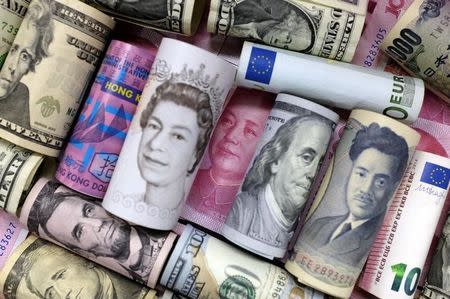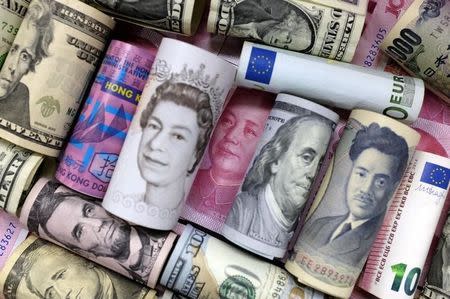Yen climbs as risk appetite sours on oil output freeze
By Jemima Kelly
LONDON (Reuters) - The yen bounced back against the dollar on Tuesday, as a modest recovery in risk appetite fizzled after top oil producers Saudi Arabia and Russia agreed to freeze - but not cut - output.
The dollar had gained over 1 percent against the safe-haven Japanese currency on Monday, and more than 3 percent since hitting a 15-month low on Thursday , as investors' nerves were calmed a touch by a recovery in shares and oil prices.
But risk appetite took a hit again and crude prices pared gains after the Saudi, Russian, Qatari and Venezuelan oil ministers dashed hopes of a deal to cut a huge oversupply of oil, proposing instead to freeze output at January levels. [O/R]
The ministers said the plan was contingent on other producers joining in - a major sticking point with Iran absent from the talks and determined to raise production.
Having earlier traded as high as 114.875 yen, the dollar fell 0.6 percent on the day to 113.98 yen after the proposal, still well above a trough of 110.985 yen touched last week.
"Oil (is) going back into retreat, and that's just sent the market reeling a bit. Prices have been trending steadily higher and then we get OPEC deciding to freeze output, which is obviously not a cut, so there's a bit of disappointment," said BNY Mellon FX strategist Neil Mellor, in London.
The euro, which usually also tends to perform well at times of risk aversion, was flat at $1.1625 .
"You've got a market that's torn between two forces at the moment: they want risk appetite to improve, they want these markets to go up, but it's clear that there's not a uniformity of views across the market," Mellor said.
Commodity-linked currencies such as the Canadian and Australian dollars pared earlier gains, though they were still up on the day.
New Zealand's dollar fell as much as 1 percent to a one-week low of $0.6581 after two-year inflation forecasts fell to their lowest since 1994, fuelling expectations of more easing from the central bank.
Against a basket of currencies, the U.S. dollar was flat, having risen around 1.5 percent since late last week. <.DXY>
"Although risky assets (have been) performing better, U.S. front-end yields are not adjusting much higher in response, which suggests the market is reluctant to price in further Fed tightening at the same time as risk sentiment is improving," said BNP Paribas currency strategist Sam Lynton-Brown in London.
"That's important for FX because it suggests that even if we have a risk on move, the extent to which the dollar is going to be able to benefit is quite limited."
(Additional reporting by Shinichi Saoshiro in Tokyo; Editing by Andrew Heavens)





